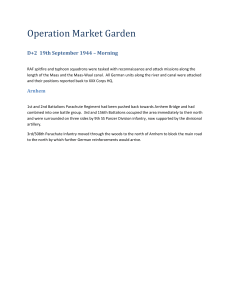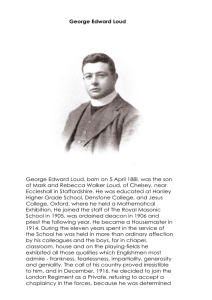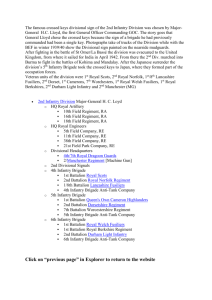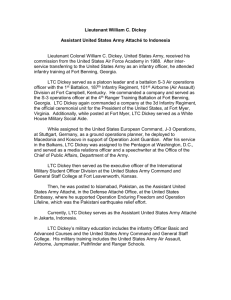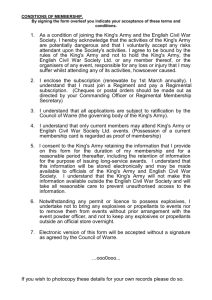The 3rd United States Infantry: “The Old Guard”
advertisement
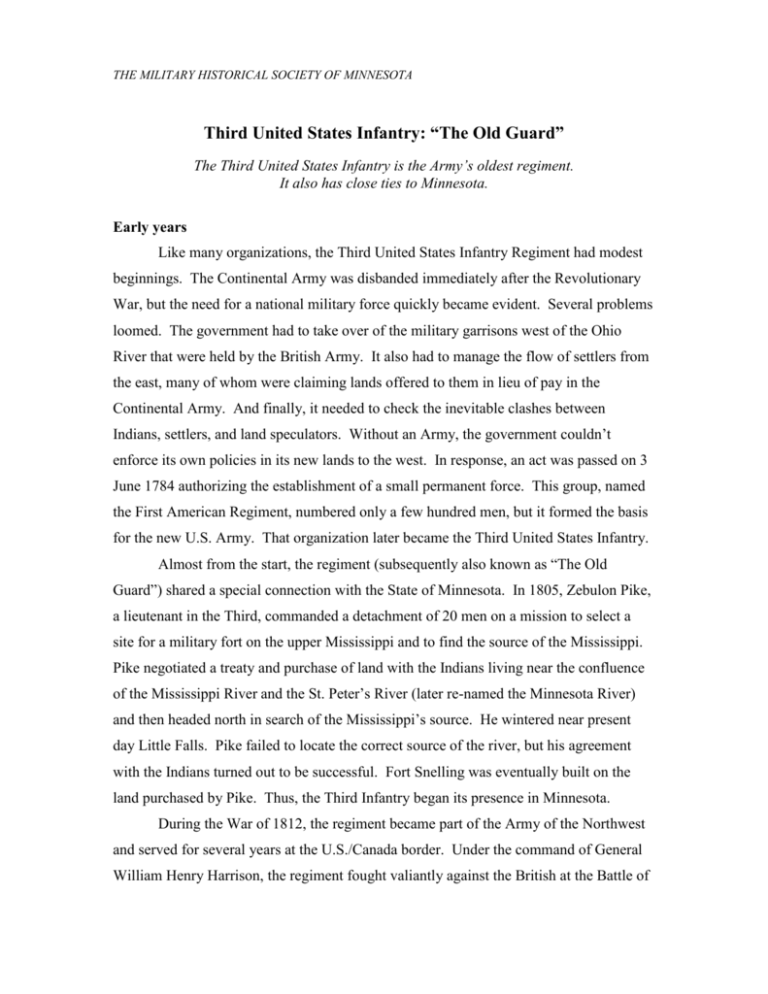
THE MILITARY HISTORICAL SOCIETY OF MINNESOTA Third United States Infantry: “The Old Guard” The Third United States Infantry is the Army’s oldest regiment. It also has close ties to Minnesota. Early years Like many organizations, the Third United States Infantry Regiment had modest beginnings. The Continental Army was disbanded immediately after the Revolutionary War, but the need for a national military force quickly became evident. Several problems loomed. The government had to take over of the military garrisons west of the Ohio River that were held by the British Army. It also had to manage the flow of settlers from the east, many of whom were claiming lands offered to them in lieu of pay in the Continental Army. And finally, it needed to check the inevitable clashes between Indians, settlers, and land speculators. Without an Army, the government couldn’t enforce its own policies in its new lands to the west. In response, an act was passed on 3 June 1784 authorizing the establishment of a small permanent force. This group, named the First American Regiment, numbered only a few hundred men, but it formed the basis for the new U.S. Army. That organization later became the Third United States Infantry. Almost from the start, the regiment (subsequently also known as “The Old Guard”) shared a special connection with the State of Minnesota. In 1805, Zebulon Pike, a lieutenant in the Third, commanded a detachment of 20 men on a mission to select a site for a military fort on the upper Mississippi and to find the source of the Mississippi. Pike negotiated a treaty and purchase of land with the Indians living near the confluence of the Mississippi River and the St. Peter’s River (later re-named the Minnesota River) and then headed north in search of the Mississippi’s source. He wintered near present day Little Falls. Pike failed to locate the correct source of the river, but his agreement with the Indians turned out to be successful. Fort Snelling was eventually built on the land purchased by Pike. Thus, the Third Infantry began its presence in Minnesota. During the War of 1812, the regiment became part of the Army of the Northwest and served for several years at the U.S./Canada border. Under the command of General William Henry Harrison, the regiment fought valiantly against the British at the Battle of Lundy’s Lane, one of the most violent conflicts in US history. When peace was declared in 1815, the Army was substantially downsized. Forty-six regiments were consolidated into eight and renumbered according to the seniority of their commanders. The newly formed regiment that happened to include the men of the old First Regiment, had a commander who was third in seniority in the Army. The unit he commanded was thereby renumbered as the Third U.S. Infantry. The regiment was later split into battalions that served in various locations on the American frontier, but it was re-united again in 1840 and sent to Florida for the Second Seminole Campaign. Traditions are born Many of the regiment’s traditions can be traced to the Mexican War (1846-48). That war began as a result of the annexation of Texas into the Union. The regiment fought valiantly at many battles during the war and played a substantial part in the capture of Mexico City. On 21 September 1846, it played a key part in capturing the Mexican city of Monterey. In terms of casualties, it was the most costly single day for the regiment until Gettysburg, and the anniversary of that day in battle was chosen in 1920 as the unit’s Organization Day. Under the command of Major General Winfield Scott, the Third Infantry, along with the Seventh Infantry and the First Artillery, charged the well-defended slopes of Cerro Gordo with fixed bayonets and captured the enemy stronghold there. In recognition of their bravery, the War Department later granted the Third Infantry Regiment the distinction of passing in review with bayonets fixed—a privilege granted to few other military units. Another fiercely defended enemy position was captured as the result of another fixed-bayonet charge by the Third at Chapultepec, the fortified military academy of Mexico. Chapultepec had to be taken in order to gain access to Mexico City. The regiment stormed the heavily defended enemy stronghold with fixed bayonets. Tradition holds that the regimental drum major charged into battle armed only with his baton. Later, Brigadier General Persifor Smith, who commanded the brigade in which the Third Infantry fought, presented the regiment with a replacement baton made of Mexican silver and wood from the flagpole of the cathedral in Mexico City’s plaza. The Chapultepec batan instantly became one of the regiment’s most revered artifacts and is now on exhibit in the Old Guard Museum at Ft. Myer, Virginia. It was for these reasons that the regiment was granted the honor of marching at the head of the troops as they paraded into Mexico City following the surrender of Mexican forces. It was there that General Scott took off his hat as the regiment passed and told his staff to “Take off your hats to the Old Guard of the Army,” giving rise to the name that would thereafter follow. After the war with Mexico, the regiment returned to frontier duty in the Southwest. The Civil War When Civil War broke out in 1861, federal troops stationed in Texas were ordered to withdraw from the state, which was sympathetic to the Confederate cause. For the Third, the line of march took them through San Antonio. To minimize the risk of trouble between the soldiers and the local populace, the regiment was ordered to take a longer route around, rather than through, the city. However, remaining true to its proud reputation, a vote was taken and it was decided that the regiment would boldly march through San Antonio in full dress uniform with colors flying, which they did— fortunately, without incident. The regiment joined the Army of the Potomac. It participated with the First Minnesota in the battles of First Bull Run, Second Bull Run, Manassas, Antietam, Fredericksburg, Chancellorsville and Gettysburg, ultimately ending their service in the conflict by being present at Lee’s surrender at Appomattox. Like many such regiments, the Third suffered terrible attrition during the war, and the Army had a poor system for manpower replacement. By war’s end, it (which at full strength would normally have ten companies and 1000 men) had only six small companies, eight officers, and 158 men. Following the Civil War, the Third Infantry was reorganized and sent off to a series of outposts in Kansas, Colorado, and Indian territories. The year 1877 was especially busy. First, the troops were transferred to Holly Springs, Mississippi, to enforce the federal civil rights law. Then it was sent to Pennsylvania to help quell railroad strike riots. In the latter part of 1877 it headed west again to Montana Territory where the Crow and the Dakota Indians were waging war against the settlers and the government. “Minnesota’s Own” The regiment was posted in 1888 to Fort Snelling, an Army installation of growing importance. Fort Snelling was also headquarters for the Army of Dakota, which included more than a dozen smaller forts spanning Minnesota, Dakota Territory and most of Montana Territory. Construction of new post facilities was well underway when the Third arrived, and by the mid-1890s, nearly all activity had migrated to the upper bluff, west of the “old fort” lower bluff area. The Army’s oldest active regiment moved into brand new spacious barracks in 1889. The regiment was quickly embraced by the locals and soon acquired the nickname “Minnesota’s Own.” It recruited most of its new members from the upper Midwest. In 1898, the Third was sent to Cuba to fight in the war with Spain. They participated in all the key battles of the conflict, including San Juan Hill and Santiago, before being sent back to Fort Snelling in September 1898. They had just returned when Minnesota’s U.S. marshal, concerned about escalating trouble with the Ojibwa on the Leech Lake Indian Reservation, requested military assistance from the Ft. Snelling regulars. Co. E was dispatched. Almost all were raw recruits. While taking some Indians into custody, a private's rifle accidentally discharged, touching off a barrage of gunfire from other Indians who had secretly surrounded the soldiers. In the ensuing three-hour battle, six Indians and six soldiers were killed, including the commander. It turned out to be the last battle between the Army and Native Americans on U.S. soil. Minnesota National Guard troops were rushed in as reinforcements and the situation was soon defused. In 1899 the Third Infantry again headed for battle—this time to Luzon in the Philippines where they engaged in jungle warfare against the Insurrectos until 1902 when they returned to the U.S. To the disappointment of many, however, they did not return to Minnesota. For the next ten years the regiment was assigned to a series of posts: Kentucky, Ohio, Alaska, and in 1909, to the island of Mindanao in the Philippines where is did police duty and assisted with road construction. The Third returned to the states in 1912, serving at Fort Ontario, New York, until 1915 when it was sent to police the Mexican border. The regiment per se stayed on the border for the next six years, although almost every man was rotated overseas for reassignment in France or Germany during and following World War One. Then in 1921, after a short span in Ohio, it was ordered back to Fort Snelling, their old home, which they had not seen in 20 years. There were no funds for transport, however, so the regiment embarked on a legendary 940-mile foot march to Fort Snelling that began on a hot July day and ended nearly four months later amidst an early November snowstorm. It was the longest foot march ever undertaken by an American military unit. “Minnesota’s Own” had returned, and in Minnesota it would stay for the next 20 years. The ‘20s and ‘30’s Like the Army itself, Fort Snelling had changed since 1899 when the Third was last stationed there. An immense new cantonment area of wooden barracks and a hospital complex had been added during World War I. The old hay barns and stables now shared space with motor pools and gas pumps. And adjoining the post was an airfield used by local flyers and a newly created Minnesota National Guard Aero Squadron. Winter equipment—skis, snowshoes, sled mounts for machine guns—had been turned in at Fort Snelling by units recently returned from the Army’s expedition in North Russia, so The Old Guard took on a special mission consistent with its location: preparation for cold weather warfare. A cyclical peacetime routine soon evolved according to the season, but the summer months were especially busy. In addition to its own training, the Third helped train National Guard and Reserve troops from surrounding states. It also provided cadre for a strenuous two-week summer program for young men (mostly high school students) called the Citizens Military Training Camp (CMTC). The CMTC, held on various Army posts around the country, gave participants a taste of military life. Although begun in the mid-1920s, it gained importance during the Depression of the 1930s because it briefly provided a structured, disciplined life, with some pay, for men not otherwise employed. Just as the Third was known as “Minnesota’s Own” during the 1880s and ‘90s, in the eyes of Minnesotans, it likewise became synonymous with the Army during the ‘20s and ‘30s. Companies of the Third marched in nearly every local parade. Weekends brought ceremonial parades on post, along with public band concerts, athletic contests, and horse shows. A legendary trick horse named “Whiskey” delighted audiences for nearly 20 years by jumping through rings of fire, leaping obstacles, and bowing to the crowd. At least once a year, the Third put on a spectacular military show featuring such crowd pleasers as tank circuses, dirigible landings, mortar and machine gun drills, and recreated World War I battles. In 1922, to emphasize its heritage, the regiment dressed its ceremonial Color Guard in Revolutionary War-style uniforms. Such activity aided recruitment into the Third, which drew most of its enlistments from Minnesota. The ‘20s and ‘30s were hard for the Army. The Great War, having been won, brought drastic reductions in military appropriations. The regiment trained as best it could with limited resources and outmoded equipment, but Fort Snelling did have a few amenities for its soldiers. It boosted a golf course, game sanctuary, tennis courts, and swimming pool. Horses were still a prominent part of Army culture. Polo matches were held on Sunday afternoons and the post was home to a hunting club that rode to the hounds. All of this lent credence to Fort Snelling’s reputation as the “Country Club of the Army” but it came to an abrupt end as the 1930s drew to a close. World War II War descended on Europe in September 1939. By mid-1940, England was under intense air and sea attack from German forces. President Roosevelt, anxious to give military aid without declaring war on Germany, struck a deal. In return for old, vintage U.S. destroyers, the British gave the U.S. use of strategically located British bases from which the U.S. could protect its shores and shipping—just in case. But the bases needed to be garrisoned by American troops. For its northern bases the Army selected the Third Infantry, which had been training for cold weather operations for 20 years. In February 1941, The Old Guard’s 3rd Battalion was sent to St. John’s, Newfoundland, becoming the first American unit shipped out of the country in anticipation of World War II. St. John’s became part of a continental defense perimeter and was on the convoy route to England and Russia. It was also used as a transfer station for aircraft ferried from American factories to the European front. The duty was cold, wet, thankless, and absolutely vital. In the meantime, another of The Old Guard’s battalions went to Ft. Leonard Wood, Missouri, where it formed the nucleus for the 66th Infantry Division, and the remaining battalion went to Greenland for a time before being split up. The last elements of the Third Infantry left Fort Snelling in1942. The regiment left its historic artifacts and records for safe keeping with the Minnesota Historical Society in St. Paul. The Newfoundland battalion was eventually built up to regimental strength and in 1943, after more than three years overseas, was rotated back to the U.S. It went first to Ft. Benning, Georgia, then to Camp Butner, North Carolina, serving as training cadre, but the German Ardennes Offensive in December 1944 brought a reversal of course. The Army quickly needed trained troops, and the regiment was shipped off to the European Theatre. It arrived in March 1945, where it was assigned to the 106th Infantry Division, but the war in Europe ended before the Third saw hard combat. The regiment was initially given responsibility for overseeing a series of POW and displaced persons camps in Germany. The following year it assumed responsibility for all civilian and internee camps in the 7th Army area, encompassing 19 installations including hospitals and SS compounds. In April 1946, it moved on to Berlin as part of the Allied Army of Occupation. Post-war Demobilization and Reorganization The regiment had performed admirably during World War Two, but it was dealt a stunning blow by “friendly fire” when the Old Guard was unceremoniously deactivated on 20 November 1946. Military bureaucrats, unmindful of the unit’s unique status as the Army’s senior regiment, simply erased it from the active rolls amid the confusion and haste of mass post-war demobilization. Members who wanted to stay in the Army were reassigned and the others were discharged. It was strange turn of events for a organization with 162 years of continuous service. Fortunately, there were still a few old soldiers left in the Army who understood the regiment’s symbolic significance. They resolved to reactivate the Third Infantry at the first opportunity. The chance came in early 1948 as what came to be known as the Cold War deepened and leaders worried that the nation’s capital needed better military protection. The Army’s oldest infantry regiment would be an ideal choice, said the old timers, and so on 6 April 1948 the Third U.S. Infantry was reborn with an activation ceremony on the Capitol Plaza in Washington, D.C. Since the end of the war, Military Police responsibilities in the Military District of Washington (MDW) had been assigned to the 703rd and 712th MP Battalions. The men from those battalions, plus a large batch of fresh trainees from Fort Dix, New Jersey, were reassigned to the newly reconstituted Third Regiment. They settled into quarters at nearby Fort Myer in Arlington, Virginia. History Rediscovered—in Minnesota The regiment’s history and traditions were reflected in a small but impressive collection of historical artifacts—uniforms, flags, memorabilia and documents that dated back to the Mexican War. They were the property of the Regiment and traveled with it from station to station over the years. When the last elements of The Old Guard left Fort Snelling in 1942, these artifacts were placed for safekeeping in the care of the Minnesota Historical Society. However, because the Third had been deactivated in Europe after the war, no one returned to reclaim the items. Moreover, when the regiment was reactivated in 1948, none of the new members were aware of the collection. The regiment’s physical ties with its past remained lost until 1951 when, by chance, MSG Jack Watts was assigned to the regiment at Fort Myer. Watts had soldiered with the Third before the war and remembered the “trophy room” at Fort Snelling where the artifacts were displayed. The regimental commander sent Watts to Fort Snelling to look for the collection. Within a few days he located them at the Minnesota Historical Society, which soon returned them to their owner. These items eventually formed the nucleus for the collection in the Old Guard Museum, begun in 1957 and located at Fort Myer. Ceremonial Duties Ceremonial duties became an important part of the Old Guard’s mission in 1950. It became—and still is—the lead unit for all Army ceremonial and escort activities in and around the nation’s capital. This included 24-hour sentinels at the Tomb of the Unknowns at Arlington National Cemetery, only a short distance from Fort Myer. It was a natural fit for the Army’s senior and most tradition-laden regiment. The Third’s Color Guard also resumed the custom (begun in the 1920s while it garrisoned at Fort Snelling) of wearing historical uniforms circa 1781, complete with white wigs and tricorn hats. Other duties were added over the years. The regiment became the official honor guard of the President in 1952. Its U.S. Army Drill Team was organized in 1957. A Fife and Drum Corps, outfitted in uniforms patterned after the musicians of General Washington’s army, was organized in 1960. Korea On 25 June 1950, 90,000 Soviet-trained troops from North Korea suddenly swept across the 38th Parallel into South Korea, overwhelming the unprepared South Korean Army. President Truman was convinced that the Soviets were using Korea as a surrogate to test American will. He secured a United Nations resolution to protect South Korea and committed US troops and supplies as part of a larger U.N. military force. General Douglas MacArthur was named to head the UN Supreme Command. American ground forces were rushed in from Japan and UN reinforcements arrived in August, halting North Korea’s swift advance. Allied counter-offensives, coupled with a risky but successful amphibious landing behind enemy lines at Inchon, enabled the Allies to drive the North Koreans back across the 38th Parallel by late September. Sensing an opportunity to unify the partitioned country, Truman authorized MacArthur to push on into North Korea. Decisive victories carried UN troops almost to Manchuria, but by December, 300,000 Chinese Communist reinforcements had slipped quietly into North Korea. Hopes for an early end to the war were dashed. Massive Chinese assaults drove the surprised and outnumbered UN forces back southward. Many U.S. troops, cut off and surrounded by Chinese, were compelled to fight their way out amid bitter winter weather that claimed as many casualties as the Communist enemy. For months the front yo-yoed up and down as each side vied for control of strategic hills in central Korea. The Army, in the meantime, scrambled to train, equip, and send as many men as it could into the fighting while also maintaining its presence in the other military installations it occupied worldwide since World War II. During this time, Third Infantry personnel were constantly rotated out as replacements for units in Korea. The entire Company H, then a provisional company of basic trainees being groomed for ceremonial duties, was shipped out of Fort Myer immediately after graduation in 1951 to serve as replacements in Korea. Like most of their fellow replacements, they never returned to their old regiment. Not until an armistice was signed in July 1953 did The Old Guard begin settle back into a routine. Vietnam Changing theories about modern warfare resulted in two major Army-wide reorganizations in the 1950s and ‘60s. In 1957 the Army adopted a “Pentomic” system in which divisions were composed of five Battle Groups instead of three infantry regiments. Throughout the Army, regiments were dropped and replaced by newly constituted Battle Groups bearing a regimental number, but without a separate regimental headquarters. Functionally, it spelled the end of a regimental system that had been in place since the Revolutionary War. In 1963 the Army switched to the “ROAD” concept (Reorganization Objectives Army Divisions) in which Battle Groups were dropped and replaced by battalions assigned to brigades. Brigades, in turn, were configured flexibly to suit a division’s particular situation. It meant that battalions could carry the name, lineage and honors of the Third U.S. Infantry, but with their own respective command structures, independent of one another and of the “parent” 1st Battalion at Fort Myer. The Army began to plan for a serious expansion of force structure as war in Vietnam escalated in 1965. In 1966, under the provisions of ROAD, a new 2nd Battalion of the Third Infantry was organized at Fort Benning and a 4th Battalion was organized at Schofield Barracks, Hawaii. Both were soon sent to Vietnam. The 2nd was assigned to the 199th Light Infantry Brigade (Separate), eventually serving in the area around Saigon. The 4th served first in the 11th Infantry Brigade and then in the 198th Infantry Brigade of the Americal Division in the I Corps area near the South Vietnam’s northern border. Neither battalion was much aware of the other, although both asked for guidance about lineage and history from time to time from the 1st Battalion back at Fort Myer. They were inactivated in 1970. Three other battalions—the 5th, 6th, and 7th—were created in 1967 as training battalions for the 6th Infantry Division at Fort Campbell. They were inactivated in 1969 and, except for a name, had no connection to the other battalions. The USAR at Fort Snelling When combat arms regiments were reorganized under the Pentomic system in 1957, the 3rd Battalion, Third infantry was withdrawn from the Regular Army and allotted to the U.S. Army Reserve (USAR). It emerged two years later on 18 May 1959 as the 3rd Battle Group, Third Infantry, USAR. It was headquartered at Fort Snelling, the regiment’s old home base, and assigned to the 103rd Infantry Division. Under ROAD it was reorganized and redesignated on 15 February 1963 as (once again) the 3rd Battalion, Third Infantry, and reassigned to the 205th Infantry Brigade. Although it was a reserve infantry outfit, the 3rd Battalion adopted many of the traditions and trappings of its Regular Army counterpart, including a crack drill team, a Color Guard with uniforms styled after the Continental Army, and an annual Organization Day banquet in honor of the regiment’s capture of Monterey, Mexico, on 21 September 1846. Military downsizing brought it all to an end, however, when the 3rd Battalion was inactivated on 25 August 1994. The Third Infantry Today The Old Guard remains stationed in the Washington, D.C. area at Fort Myer and now also at Fort McNair. It is still charged with the unique mission of providing security for the nation’s capital while also serving as the Army’s official ceremonial unit. Currently designated as 1st Battalion, Third U.S. Infantry, it is made up of eight companies. Company A is the Commander-in-Chief’s Guard. Companies B, C, and D are line companies that share ceremonial, memorial, and field training activities. Each company includes a marching platoon, firing-party platoon, and casket-team platoon. Company E (Honor Guard) has additional platoons that serve as Honor and Color Guards. Company H is comprised of the Presidential Salute Gun Battery, Caisson Platoon, Drill Team, and the 289th MP Company. The 70-member Fife and Drum Corps is the seventh company. Headquarters Company (the eighth company) provides leadership and support. Their distinctive dress-blue uniforms and crisp military bearing have become a familiar sight to Americans and others who see them in the ceremonies and special functions that showcase the Army. The Third is not just about show, however. It is also an infantry unit with a demanding, year-round combat readiness training schedule for all its soldiers. When the Pentagon was attacked on 11 September 2001, the Third was immediately dispatched to the scene. It, too, was fitting duty for the disciplined and ever-ready “Old Guard.”


